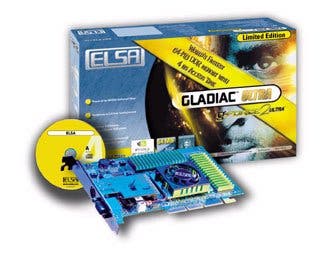ELSA Gladiac Ultra
Review - the extremists' graphics card of choice, but just what does it have to offer, and is it really worth buying in the current climate?
- ELSAPrice - £399.99

Catch 22
Graphics cards are a tough kettle of fish these days. Most people will tell you that the sweet spot of the market at the moment is the GeForce MX, which retails for a smidgeon under a hundred notes and provides you with all sorts of popular features like dual-monitor output, Digital Vibrance Control for improved imagery and the NVIDIA Shading Rasterizer, which incorporates per-pixel shading to make sure 3D elements look and behave like their real-life counterparts. Others will tell you it's the GeForce 2 GTS. After all, with the GeForce 3 due to launch at a colossal price, you really ought to buy something that will last you until Christmas when the market is reasonable again, at which point you'll want one of them. And if you're not a fan of Ge-tech, you'll be advised to seek out the ATI Radeon, which embraces most of the features hardware gurus have come to know and love, like Transform and Lighting, at a reasonable price/performance ratio. The thing is, whoever you talk to, no-one seems eager to discuss NVIDIA's "other" GPU, the eponymous GeForce 2 Ultra. As the forerunner to the GeForce 3, the Ultra functions very much like the TNT2 Ultra - it's fundamentally a spruced up vanilla GeForce 2, with a higher clock rate, more memory, faster memory and on the whole a featureset to die for. The reasons for the Ultra's lack of popularity are twofold: there is no demand for it, and it's hideously overpriced. Which is a shame, because even with only a few weeks to go until NVIDIA's first big release for quite a while, the Ultra is still top of the tree.

Ultra
When NVIDIA launched the GeForce 2 Ultra, it met with critical acclaim. Some worshipped it for its performance, others scalded it for its unreasonable price tag, but rather unfortunately, nobody bought it. Having tracked down one of the top-line GeForce 2 Ultras, the ELSA Gladiac Ultra, we sought to find out why for ourselves. The first bombshell is that the Ultra's architecture is actually identical to that of the GeForce 2 GTS. It's not a new card. The four familiar rendering pipelines happily co-exist, and like the GTS, the Ultra can process two textures per pipeline per clock. The difference is that the GPU on the Ultra has been subjected to a souped up fabrication process that yields chips capable of higher clock speeds. The core clock speed of the Gladiac Ultra is 250MHz DDR. The 64Mb of memory on the card is 4ns SDRAM clocked at 460MHz. In our limited experience with overclocking the Ultra, the memory reached over 500MHz before imperfections started to manifest themselves. The memory is covered by "RAMsinks," which help prevent overheating. The application of these is certainly better than the rather shoddy job done on the original Hercules 3D Prophet II GTS, which we felt were rather unhelpful. Unlike some Ultra designs, there is no space for a TV/out unit, nor a DVI output. The board is fairly featureless as Ultras go, although it does ship with the "Revelator" 3D glasses, but these proved difficult to configure using any of the monitors on our testbed. Apparently if your monitor isn't amongst those supported, you can look forward to all sorts of quite literally headache-inducing trauma getting them up and running. The Revelators work by fooling your eyes into seeing depth, hence three dimensions. The effect when we eventually got it running was far from optimal, but proved an interesting enough diversion for a rainy afternoon.
Testing
ELSA's drivers are pretty basic - the only reason to install them at all is to add support for the Revelators, which regrettably don't work with the reference "Detonator" releases from NVIDIA. Once we'd finished with the Revelators, we exchanged the ELSA drivers for the Detonator 3s, version 6.50, which are NVIDIA's currently approved release. A point of note here - if you do intend to use the ELSA drivers, be aware that they restrict a lot of resolutions that you might want to use. Here on the testing line we tend to go for the proportionally-correct 1280x960 for everyday use, but the ELSA drivers lock you down to either 1152x864 or 1280x1024, which squishes things ever so slightly on the vertical. A minor point for many, but worth mentioning. Anyway, for our tests, we pitted the Ultra against another ELSA card, the Gladiac 2 GTS, and a competing card, the 64Mb ATI Radeon DDR, using a 1GHz Athlon and a 750MHz Athlon. However, it's fairly obvious from our experiences that the GeForce 2 Ultra is the best-performing card on the market at the moment, so these benchmarks prove fairly arbitrary.
1GHz Athlon tests
750MHz Athlon tests
One of the things we found most impressive was the Ultra's performance with FSAA. Using the most load-heavy FSAA options in 800x600 with 32-bit colour, the card turned an incredibly respectable 60 frames per second in our Quake III benchmark on a 1GHz Athlon. At 1024x768 things got a little hectic, with the rate dropping to about 35-40 fps, but on the whole the effect was startling. The image quality that the GeForce 2 Ultra offers is second to none in the current market.
Conclusions
Despite the impressive benchmarks and the figure-hugging stats though, we don't think the GeForce 2 Ultra is worth the money. At £350 compared to only £250 for the Gladiac 2 GTS... the benchmarks speak for themselves. Can you really justify a mere 15 frames per second extra at 1024x768 for a price hike of £100? The problem for the Ultra is that everybody to whom it should appeal already owns a good enough graphics card. You really have to scrape the bottom of the barrel before the Ultra looks like a viable proposition. People who own TNT2 Ultras and Voodoo3 3500s could just about warrant the expenditure if they are not prepared to wait for the GeForce 3 to drop in price, but to anybody who owns even a GeForce SDR, the cost is absurd. This writer's own personal GeForce 2 GTS replaced the Ultra a couple of days ago, and in the games regularly played on this system; Quake III and Half-Life: Counter-Strike, the difference in performance was negligible. The GeForce 2 Ultra serves one purpose - to offer an extremists' choice in video cards. Like the TNT2 Ultra, it's impossible to justify the cost based on the performance defecit between the vanilla GTS and the Ultra, especially with the GeForce 3 merely weeks away and with so much more to offer than this. If you are wondering whether to take the plunge now or wait for the GeForce 3, we implore you to take our advice and wait. The GeForce 3 will feature an entirely new GPU and judging by the recent demonstrations with John Carmack of Doom 3, will be the card to own in the next year. We foresee it being much easier to justify the extravagance when there is a genuine improvement to speak of, but with the Ultra, we're looking at a few new stats - nothing more. Related Features:- Play Your Cards Right Hercules Prophet II MX Review








